Voronezh
Voronezh (Russian: Воронеж, IPA: [vɐˈronʲɪʂ]), also romanised as Voronež, is a city and the administrative centre of Voronezh Oblast, Russia, straddling the Voronezh River and located 12 kilometers (7.5 mi) from where it flows into the Don. The city sits on the Southeastern Railway, which connects European Russia with the Urals and Siberia, the Caucasus and Ukraine, and the M4 highway (Moscow–Voronezh–Rostov-on-Don–Novorossiysk). Its population in 2019 was estimated to be 1,054,111;[13] up from 889,680 recorded in the 2010 Census;[6] it is the thirteenth most populous city in the country.
Voronezh Воронеж | |
|---|---|
City[1] | |
 View of Voronezh | |
 Flag 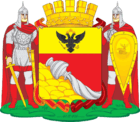 Coat of arms | |
Location of Voronezh 
| |
 Voronezh Location of Voronezh .svg.png) Voronezh Voronezh (Voronezh Oblast) | |
| Coordinates: 51°40′18″N 39°12′38″E | |
| Country | Russia |
| Federal subject | Voronezh Oblast[1] |
| Founded | 1585[2] or much earlier[3] |
| City status since | 1585[4] |
| Government | |
| • Body | City Duma |
| • Mayor | Vadim Kstenin |
| Area | |
| • Total | 601 km2 (232 sq mi) |
| Elevation | 154 m (505 ft) |
| Population | |
| • Total | 889,680 |
| • Estimate (2018)[7] | 1,047,549 (+17.7%) |
| • Rank | 15th in 2010 |
| • Density | 1,500/km2 (3,800/sq mi) |
| • Subordinated to | Voronezh Urban Okrug[1] |
| • Capital of | Voronezh Oblast[1], Voronezh Urban Okrug[1] |
| • Urban okrug | Voronezh Urban Okrug[8] |
| • Capital of | Voronezh Urban Okrug[8] |
| Time zone | UTC+3 (MSK |
| Postal code(s)[10] | 394000–394095 |
| Dialing code(s) | +7 473[11] |
| OKTMO ID | 20701000001 |
| City Day | Third Saturday of September[12] |
| Twin towns | Charlotte, Chongqing, Brno, Homieĺ, Wesermarsch, Sliven, León, Gorzów Wielkopolski, Luhansk |
| Website | www |
History
Foundation and name
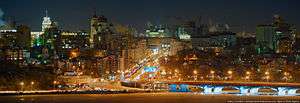
The first chronicle references to the word "Voronezh" are dated 1177, when the Ryazan prince Yaropolk, having lost the battle, fled "to Voronozh" and there was moving "from hail into hail." Modern data of archeology and history interpret Voronezh as a geographical region, which included the Voronezh river (tributary of the Don) and a number of settlements. In the lower reaches of the river, a unique Slavic town-planning complex of the 8th – early 11th century was discovered, which covered the territory of the present city of Voronezh and its environs (about 42 km long, about 13 forts and many unfortified villages). By the 12th – 13th centuries, most of the old “hails” were desolate, but new settlements appeared upstream, closer to Ryazan.[14][15][16][17]
For many years, the hypothesis of the Soviet historian Vladimir Zagorovsky dominated: he produced the toponym "Voronezh" from the hypothetical Slavic personal name Voroneg. This man allegedly gave the name of a small town in the Chernigov Principality (now the village of Voronezh in Ukraine[18]). Later, in the XI or XII centuries, the settlers were able to "transfer" this name to the Don region, where they named the second city Voronezh, and the river got its name from the city.[19][20] However, now many researchers criticize the hypothesis, since in reality neither the name of Voroneg nor the second city was revealed, and usually the names of Russian cities repeated the names of the rivers, but not vice versa.
The linguistic comparative analysis of the name "Voronezh" was carried out by the Khovansky Foundation in 2009. There is an indication of the place names of many countries in Eurasia, which may partly be not only similar in sound, but also united by common Indo-European languages: Varanasi, Varna, Verona, Brno, etc.[21]
A comprehensive scientific analysis was conducted in 2015–2016 by the historian Pavel Popov. His conclusion: "Voronezh" is a probable Slavic macrotoponym associated with outstanding signs of nature, has a root voron- (from the proto-Slavic vorn) in the meaning of "black, dark" and the suffix -ezh (-azh, -ozh). It was not “transferred” and in the 8th - 9th centuries it marked a vast territory covered with black forests (oak forests) - from the mouth of the Voronezh river to the Voronozhsky annalistic forests in the middle and upper reaches of the river, and in the west to the Don (many forests were cut down). The historian believes that the main "city" of the early town-planning complex could repeat the name of the region – Voronezh. Now the hillfort is located in the administrative part of the modern city, in the Voronezh upland oak forest. This is one of Europe's largest ancient Slavic hillforts, the area of which – more than 9 hectares – 13 times the area of the main settlement in Kiev before the baptism of Rus.[17][22]
Folk etymology claims the name comes from combining the Russian words for raven (ворон) and hedgehog (еж) into Воронеж. According to this explanation two Slavic tribes named after the animals used this combination to name the river which later in turn provided the name for a settlement. There is not believed to be any scientific support for this explanation.
In the 16th century, the Middle Don basin, including the Voronezh river, was gradually conquered by Muscovy from the Nogai Horde (a successor state of the Golden Horde), and the current city of Voronezh was established in 1585 by Feodor I as a fort protecting the Muravsky Trail trade route against the raids of the Nogai and Crimean Tatars. The city was named after the river.[2]
17th to 20th centuries
In the 17th century, Voronezh gradually evolved into a sizable town. Weronecz is shown on the Worona river in Resania in Joan Blaeu's map of 1645.[23] Peter the Great built a dockyard in Voronezh where the Azov Flotilla was constructed for the Azov campaigns in 1695 and 1696. This fleet, the first ever built in Russia, included the first Russian ship of the line, Goto Predestinatsia. The Orthodox diocese of Voronezh was instituted in 1682 and its first bishop, Mitrofan of Voronezh, was later proclaimed the town's patron saint.
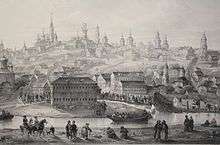
Owing to the Voronezh Admiralty Wharf, for a short time, Voronezh became the largest city of South Russia and the economic center of a large and fertile region. In 1711, it was made the seat of the Azov Governorate, which eventually morphed into the Voronezh Governorate.
In the 19th century, Voronezh was a center of the Central Black Earth Region. Manufacturing industry (mills, tallow-melting, butter-making, soap, leather, and other works) as well as bread, cattle, suet, and the hair trade developed in the town. A railway connected Voronezh with Moscow in 1868 and Rostov-on-Don in 1871.
During World War II, Voronezh was the scene of fierce fighting between Russian and combined Axis troops. The Germans used it as a staging area for their attack on Stalingrad, and made it a key crossing point on the Don River. In June 1941, two BM-13 (Fighting machine #13 Katyusha) artillery installations were built at the Voronezh excavator factory. In July, the construction of Katyushas was rationalized so that their manufacture became easier and the time of volley repetition was shortened from five minutes to fifteen seconds. More than 300 BM-13 units manufactured in Voronezh were used in a counterattack near Moscow in December 1941. In October 22, 1941, the advance of the German troops prompted the establishment of a defense committee in the city. On November 7, 1941, there was a troop parade, devoted to the anniversary of the October Revolution. Only three such parades were organized that year: in Moscow, Kuybyshev, and Voronezh. In late June 1942, the city was attacked by German and Hungarian forces. In response, Soviet forces formed the Voronezh Front. By July 6, the German army occupied the western river-bank suburbs before being subjected to a fierce Soviet counter-attack. By July 24 the frontline had stabilised along the Voronezh River as the German forces continued southeast into the Great Bend of the Don. The attack on Voronezh represented the first phase of the German Army's 1942 campaign in the Soviet Union, codenamed Case Blue.
Until January 25, 1943, parts of the Second German Army and the Second Hungarian Army occupied west part of Voronezh. During Operation Little Saturn, the Ostrogozhsk–Rossosh Offensive, and the Voronezhsko-Kastornenskoy Offensive, the Voronezh Front exacted heavy casualties on Axis forces. On January 25, 1943, Voronezh was liberated after ten days of combat. During the war the city was almost completely ruined, with 92% of all buildings destroyed.
1950s–2000s
By 1950, Voronezh had been rebuilt. Most buildings and historical monuments were repaired. It was also the location of a prestigious Suvorov Military School, a boarding school for young boys who were considered to be prospective military officers, many of whom had been orphaned by war.[24]
In 1950–1960, new factories were established: a tire factory, a machine-tool factory, a factory of heavy mechanical pressing, and others. In 1968, Serial production of the Tupolev Tu-144 supersonic plane was established at the Voronezh Aviation factory. In October 1977, the first Soviet domestic wide-body plane, Ilyushin Il-86, was built there.
In 1989, TASS published details of an alleged UFO landing in the city's park and purported encounters with extraterrestrial beings reported by a number of children. A Russian scientist that was cited in initial TASS reports later told the Associated Press that he was misquoted, cautioning, "Don't believe all you hear from TASS," and "We never gave them part of what they published",[25] and a TASS correspondent admitted the possibility that some "make-believe" had been added to the TASS story, saying, "I think there is a certain portion of truth, but it is not excluded that there is also fantasizing".[26][27]
2010s
From 10 to 17 September 2011, Voronezh celebrated its 425th anniversary. The anniversary of the city was given the status of a federal scale celebration that helped attract large investments from the federal and regional budgets for development.[28]
On December 17, 2012, Voronezh became the fifteenth city in Russia with a population of over one million people.[29]
Today Voronezh is the economic, industrial, cultural, and scientific center of the Central Black Earth Region.
Administrative and municipal status

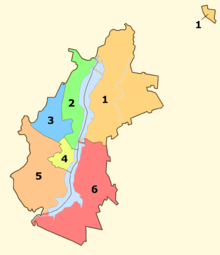
Voronezh is the administrative center of the oblast.[1] Within the framework of administrative divisions, it is incorporated as Voronezh Urban Okrug—an administrative unit with the status equal to that of the districts.[1] As a municipal division, this administrative unit also has urban okrug status.[8]
City divisions
The city is divided into six administrative districts:
- 1. Zheleznodorozhny (183,17 km²)
- 2. Tsentralny (63,96 km²)
- 3. Kominternovsky (47,41 km²)
- 4. Leninsky (18,53 km²)
- 5. Sovetsky (156,6 km²)
- 6. Levoberezhny (123,89 km²)
Demographics
| 1615 | 1777 | 1840 | 1897 | 1923 | 1939 | 1959 | 1973 | 1989 | 1997 |
|---|---|---|---|---|---|---|---|---|---|
| 7,000 | 13,000 | 43,800 | 80,599 | 95,000 | 326,932 | 447,164 | 713,000 | 886,844 | 905,000 |
| 2010[6] | 2011 | 2012 | 2013 | 2014 | 2015 | 2016[30] | |||
| 889,680 | 979,884 | 991,269 | 1,003,638 | 1,014,610 | 1,023,570 | 1,032,895 |
Note: 1926–1970 and 2016 are population estimates; 1989 is the Soviet Census; 2002 and 2010 are census urban population only.
Economy
The leading sectors of the urban economy in the 20th century were mechanical engineering, metalworking, the electronics industry and the food industry.
In the city are such companies as:
- Voronezh Aircraft Production Association (where, amongst other types, the Tupolev Tu-144 was built)
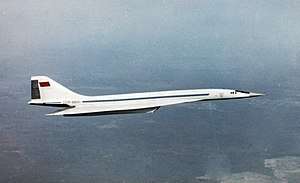
- Voronezhselmash (agricultural engineering)
- Sozvezdie[31] (headquarter, JSC Concern “Sozvezdie”, in 1958 the world's first created mobile telephony and wireless telephone Altai
- Verofarm (pharmaceutics, owner Abbott Laboratories),
- Voronezh Mechanical Plant[32] (production of missile and aircraft engines, oil and gas equipment)
- Mining Machinery Holding - RUDGORMASH[33] (production of drilling, mineral processing and mining equipment)
- VNiiPM Research Institute of Semiconductor Engineering[34] (equipment for plasma-chemical processes, technical-chemical equipment for liquid operations, water treatment equipment)
- KBKhA Chemical Automatics Design Bureau with notable products:.[35]
- Pirelli Voronezh.[36]
On the territory of the city district government Maslovka Voronezh region with the support of the Investment Fund of Russia, is implementing a project to create an industrial park, "Maslowski", to accommodate more than 100 new businesses, including the transformer factory of Siemens. On September 7, 2011 in Voronezh there opened a Global network operation center of Nokia Siemens Networks, which was the fifth in the world and the first in Russia.
Building
In 2014, 926,000 square meters of housing was delivered.[37]
Clusters of Voronezh
In clusters of tax incentives and different preferences, the full support of the authorities. A cluster of Oil and Gas Equipment, Radio-electronic cluster, Furniture cluster, IT cluster, Cluster aircraft, Cluster Electromechanics, Transport and logistics cluster, Cluster building materials and technologies.[38]
Transportation
Air
The city is served by the Voronezh International Airport, which is located north of the city and is home to Polet Airlines. Voronezh is also home to the Pridacha Airport, a part of a major aircraft manufacturing facility VASO (Voronezhskoye Aktsionernoye Samoletostroitelnoye Obshchestvo, Voronezh aircraft production association) where the Tupolev Tu-144 (known in the West as the "Concordski"), was built and the only operational unit is still stored. Voronezh also hosts the Voronezh Malshevo air force base in the southwest of the city, which, according to a Natural Resources Defense Council report, houses nuclear bombers.
Rail

Since 1868, there is a railway connection between Voronezh and Moscow.[39] Rail services form a part of the South Eastern Railway of the Russian Railways. Destinations served direct from Voronezh include Moscow, Kiev, Kursk, Novorossiysk, Sochi, and Tambov. The main train station is called Voronezh-1 Railway Station and is located in the center of the city.
Climate
Voronezh experiences a humid continental climate (Köppen: Dfb) with long, cold winters and short, warm summers.[40]
| Climate data for Voronezh | |||||||||||||
|---|---|---|---|---|---|---|---|---|---|---|---|---|---|
| Month | Jan | Feb | Mar | Apr | May | Jun | Jul | Aug | Sep | Oct | Nov | Dec | Year |
| Record high °C (°F) | 8.0 (46.4) |
11.0 (51.8) |
19.4 (66.9) |
29.2 (84.6) |
35.7 (96.3) |
38.9 (102.0) |
40.1 (104.2) |
40.5 (104.9) |
32.1 (89.8) |
26.5 (79.7) |
18.1 (64.6) |
12.4 (54.3) |
40.5 (104.9) |
| Average high °C (°F) | −3.4 (25.9) |
−3.0 (26.6) |
2.9 (37.2) |
13.9 (57.0) |
21.1 (70.0) |
24.5 (76.1) |
26.6 (79.9) |
25.6 (78.1) |
18.9 (66.0) |
10.9 (51.6) |
2.3 (36.1) |
−2.5 (27.5) |
11.5 (52.7) |
| Daily mean °C (°F) | −6.1 (21.0) |
−6.5 (20.3) |
−1.0 (30.2) |
8.3 (46.9) |
14.8 (58.6) |
18.5 (65.3) |
20.5 (68.9) |
19.2 (66.6) |
13.3 (55.9) |
6.9 (44.4) |
−0.4 (31.3) |
−5.0 (23.0) |
6.9 (44.4) |
| Average low °C (°F) | −8.8 (16.2) |
−9.3 (15.3) |
−4.2 (24.4) |
3.6 (38.5) |
9.3 (48.7) |
13.2 (55.8) |
15.2 (59.4) |
13.7 (56.7) |
8.7 (47.7) |
3.6 (38.5) |
−2.6 (27.3) |
−7.6 (18.3) |
2.9 (37.2) |
| Record low °C (°F) | −36.5 (−33.7) |
−36.2 (−33.2) |
−32.0 (−25.6) |
−16.8 (1.8) |
−3.3 (26.1) |
−1.6 (29.1) |
5.0 (41.0) |
0.4 (32.7) |
−5.2 (22.6) |
−15.2 (4.6) |
−25.1 (−13.2) |
−33.4 (−28.1) |
−36.5 (−33.7) |
| Average precipitation mm (inches) | 41 (1.6) |
37 (1.5) |
33 (1.3) |
38 (1.5) |
46 (1.8) |
74 (2.9) |
62 (2.4) |
52 (2.0) |
61 (2.4) |
50 (2.0) |
46 (1.8) |
44 (1.7) |
584 (23.0) |
| Average rainy days | 8 | 6 | 8 | 12 | 13 | 15 | 13 | 10 | 13 | 14 | 13 | 9 | 134 |
| Average snowy days | 21 | 20 | 14 | 3 | 0.2 | 0 | 0 | 0 | 0.1 | 3 | 12 | 20 | 93 |
| Average relative humidity (%) | 84 | 82 | 77 | 66 | 61 | 67 | 68 | 67 | 73 | 79 | 85 | 85 | 75 |
| Mean monthly sunshine hours | 62 | 86 | 125 | 184 | 268 | 284 | 286 | 254 | 185 | 111 | 45 | 38 | 1,928 |
| Source 1: Pogoda.ru.net,[41] | |||||||||||||
| Source 2: NOAA (sun, 1961–1990)[42] | |||||||||||||
Education and culture
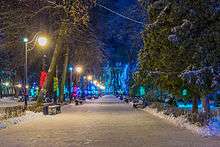
The city has seven theaters, twelve museums, a number of movie theaters, a philharmonic hall, and a circus. It is also a major center of higher education in central Russia. The main educational facilities include:
- Voronezh State University
- Voronezh State Technical University
- Voronezh State University of Architecture and Construction
- Voronezh State Pedagogical University
- Voronezh State Agricultural University
- Voronezh State University of Engineering Technologies
- Voronezh State Medical University named after N. N. Burdenko
- Voronezh State Academy of Arts
- Voronezh State University of Forestry and Technologies named after G.F. Morozov
- Voronezh State Institute of Physical Training
- Voronezh Institute of Russia's Home Affairs Ministry
- Voronezh Military Aviation Engineering University
- Voronezh Institute of High Technologies
- Voronezh Air Force Academy named after Prof. Zhukovsky and Gagarin
- Plekhanov Russian University of Economics (Voronezh branch)
- Russian State University of Justice[43]
- Admiral Makarov State University of Sea and River Fleet (Voronezh branch)
- International Institute of Computer Technologies
- Voronezh Institute of Economics and Law
and a number of other affiliate and private-funded institutes and universities. There are 2000 schools within the city.
Theaters
- Voronezh Chamber Theatre[44]
- Koltsov Academic Drama Theater[45]
- Voronezh State Opera and Ballet Theatre[46]
- Shut Puppet Theater[47]
Festivals
Sports
| Club | Sport | Founded | Current League | League Rank | Stadium |
|---|---|---|---|---|---|
| Fakel Voronezh | Football | 1947 | Russian Football National League | 2nd | Tsentralnyi Profsoyuz Stadion |
| Energy Voronezh | Football | 1989 | Women's Premier League | 1st | Rudgormash Stadium |
| Buran Voronezh | Ice Hockey | 1977 | Higher Hockey League | 2nd | Yubileyny Sports Palace |
| VC Voronezh | Volleyball | 2006 | Women's Higher Volleyball League A | 2nd | Kristall Sports Complex |
Religion
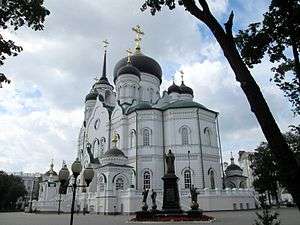
Orthodox Christianity is the prevalent religion in Voronezh.
There is an orthodox Jewish community in Voronezh, with a synagogue located on Stankevicha Street.[49][50]
Notable people

Sister Cities
Source:[51]
| Date | Sister City | |
|---|---|---|
| 1968 | Brno, Czech Republic[52][53] | |
| 1989 | Wesermarsch, Lower Saxony, Germany | |
| 1991 | Charlotte, North Carolina, United States | |
| 1992 | Chongqing, China | |
| 1995 | Sliven, Bulgaria | |
| 1996 | León, Castile and León, Spain[54] |
References
Notes
- Law #87-OZ
- Историческая хроника (DOC) (in Russian). Муниципальное учреждение культуры Централизованная библиотечная система города Воронежа Центральная городская библиотека имени А. Платонова. 2009. Retrieved March 28, 2012.
- Воронеж может оказаться намного старше (in Russian). Вести. August 19, 2010. Retrieved March 28, 2012.
- "История". Voronezh-city.ru. Retrieved December 16, 2016.
- "База данных показателей муниципальных образований". Gks.ru. Retrieved July 22, 2015.
- Russian Federal State Statistics Service (2011). "Всероссийская перепись населения 2010 года. Том 1" [2010 All-Russian Population Census, vol. 1]. Всероссийская перепись населения 2010 года [2010 All-Russia Population Census] (in Russian). Federal State Statistics Service.
- "26. Численность постоянного населения Российской Федерации по муниципальным образованиям на 1 января 2018 года". Federal State Statistics Service. Retrieved January 23, 2019.
- Law #66-OZ
- "Об исчислении времени". Официальный интернет-портал правовой информации (in Russian). June 3, 2011. Retrieved January 19, 2019.
- "Каталог компаний, справочник компаний России: Желтые страницы России - Евро Адрес". E-adres.ru. Archived from the original on August 30, 2009. Retrieved July 22, 2015.
- "Рекетнммши Йнд Цнпндю Бнпнмеф". Kody.su. Retrieved December 16, 2016.
- "День города Воронеж 2015". Mir36.ru. Retrieved July 22, 2015.
- Russia: Federal Districts and Major Cities
- В. П. Загоровский. "Воронежская историческая энциклопедия". Воронеж, 1992. Стр. 53.
- А. З. Винников, А. Т. Синюк. "Дорогами тысячелетий: Археологи о древней истории Воронежского края". Издание 2-е. Воронеж, 2003. Стр. 185–187, 236–242.
- Н. А. Тропин. "Южные территории Чернигово-Рязанского порубежья в XII–XV вв." Автореферат диссертации на соискание ученой степени доктора исторических наук. Москва, 2007.
- П. А. Попов. "Воронеж: древнее слово и древние города, а также древние леса и древние реки России". Воронеж, 2016.
- Woroneż (Wronasz) is shown on the Woroneż river by Stefan Kuczyński (1936) in a historical map of 15th-century Chernigov, «Ziemie Czernihowsko-Siewierskie pod rządami Litwy».
- В. П. Загоровский. "О древнем Воронеже и слове «Воронеж»". Издание 2-е. Воронеж, 1977.
- Е. М. Поспелов. "Географические названия мира". Москва, 1998. Стр. 104.
- А. Лазарев. "Тайна имени Воронежъ" (The Mystery of the Name of Voronezh). Воронеж, 2009.
- П. А. Попов. "Комплексный подход в топонимических исследованиях в связи с историей русского градостроительства (на примере Центрального Черноземья)". Девятые всероссийские краеведческие чтения (Москва – Воронеж, 15–19 мая 2015 г.). Москва; Воронеж, 2016. Стр. 423–434.
- Russiæ, vulgo Moscovia, pars australis in Theatrum Orbis Terrarum, sive Atlas Novus in quo Tabulæ et Descriptiones Omnium Regionum, Editæ a Guiljel et Ioanne Blaeu, 1645.
- Alex Levin, Under The Yellow & Red Stars Archived August 9, 2016, at the Wayback Machine (Azrieli Foundation, 2009), pp. 45ff., "The Suvorov Military School".
- Dahlberg, John-Thor (October 11, 1989). "Voronzeh Scientist Quoted by TASS Casts Doubt on UFO Landing Story". Associated Press. Retrieved March 21, 2014.
- "UFO lands in Russia? Writer now waffles". United Press International. October 10, 1989. Retrieved March 21, 2014.
- Fein, Esther B.; Times, Special To The New York (October 11, 1989). "U.F.O. Landing Is Fact, Not Fantasy, the Russians Insist". The New York Times. p. 6.
- Интерактивная карта подготовки к 425-летию основания Воронежа (рус.). Сайт администрации города Воронеж (31.08.11). Проверено 24 января 2011
- "В Воронеже родился миллионный житель". РБК. Archived from the original on March 5, 2013. Retrieved July 22, 2015.
- Voronezh Territorial Branch of the Federal State Statistics Service. , Voronezhstat.gks.ru, (in Russian)
- "Главная страница - АО "Концерн «Созвездие"". Vsm-sorter.com. Retrieved July 22, 2015.
- "Voronezh Mechanical Plant". Vmzvrn.ru. Retrieved July 22, 2015.
- "MMHC RUDGORMASH Mining Machinery Holding Company". Mmhc-rudgormash.com. Retrieved July 22, 2015.
- "НИИПМ-->О компании-->Институт сегодня". Vniipm.ru. Retrieved July 22, 2015.
- ""Конструкторское Бюро Химавтоматики" - Главная". Kbkha.ru. Retrieved July 22, 2015.
- "Pirelli, Russian Technologies joint venture launches technologically advanced second production line at Voronezh". Pirelli.com. Retrieved July 22, 2015.
- "Официальный портал органов власти". Govvrn.ru. Archived from the original on July 2, 2015. Retrieved July 22, 2015.
- "Главная - ЦКР". Cluster36.ru. Retrieved July 22, 2015.
- "Жд вокзал Воронеж | Оригинал жд билета | Жд билеты | Международный аэропорт "Стригино" г. Нижний Новгород, РЖД билет, купить ж д билет, рейсы самолетов в нижний новгород, телефоны справочного бюро аэропорта стригино, заказ ж/д билетов, стоимость жд билетов, билеты на поезд, бронирование, авиарейсы - Аэропорт Нижний Новгород - Нижегородский аэропорт - сайт аэропорта нижний новгород стригино - МЕЖДУНАРОДНЫЙ АЭРОПОРТ НИЖНИЙ НОВГОРОД". Nnov-airport.ru. Archived from the original on June 30, 2017. Retrieved December 16, 2016.
- "Voronezh, Russia Köppen Climate Classification (Weatherbase)". Weatherbase. Retrieved November 13, 2018.
- "Pogoda.ru.net" (in Russian). Weather and Climate (Погода и климат). Retrieved December 10, 2015.
- "Voronez (Voronezh) Climate Normals 1961–1990". National Oceanic and Atmospheric Administration. Retrieved December 10, 2015.
- "О филиале". Cb.rgup.ru. Retrieved July 22, 2015.
- "Воронежский камерный театр". Chambervrn.ru. Archived from the original on August 21, 2015. Retrieved July 22, 2015.
- "Воронежский Академический Театр драмы им. А. Кольцова". Voronezhdrama.ru. Retrieved July 22, 2015.
- "Воронежский государственный театр оперы и балета – официальный сайт". Theatre-vrn.ru. Retrieved July 22, 2015.
- ".:. Òåàòð Êóêîë - "ØÓÒ" .:". Puppet-shut.ru. Retrieved July 22, 2015.
- "Фестиваль". Platonovfest.com. Retrieved July 22, 2015.
- "В Воронеже открыли одну из крупнейших синагог России". Rg.ru. Retrieved December 16, 2016.
- "The Jewish Community of Voronezh". evrei-vrn.ru. Retrieved August 6, 2016.
- Рациональная маршрутная сеть. "Воронеж: официальный сайт администрации городского округа". Voronezh-city.ru. Retrieved March 12, 2013.
- "City of Brno Foreign Relations - Statutory city of Brno" (in Czech). 2.brno.cz. Archived from the original on January 15, 2016. Retrieved September 6, 2011.
- "Brno - Partnerská města" (in Czech). Brno.cz. Retrieved July 17, 2009.
- "Ciudades y pueblos se benefician del hermanamiento con otros territorios". Larazon.es. Retrieved September 16, 2011.
Sources
- Воронежская областная Дума. Закон №87-ОЗ от 27 октября 2006 г. «Об административно-территориальном устройстве Воронежской области и порядке его изменения», в ред. Закона №41-ОЗ от 13 апреля 2015 г. «О внесении изменений в Закон Воронежской области "Об административно-территориальном устройстве Воронежской области и порядке его изменения"». Вступил в силу по истечении 10 дней со дня официального опубликования. Опубликован: "Молодой коммунар", №123, 3 ноября 2006 г. (Voronezh Oblast Duma. Law #87-OZ of October 27, 2006 On the Administrative-Territorial Structure of Voronezh Oblast and on the Procedures of Changing It, as amended by the Law #41-OZ of April 13, 2015 On Amending the Law of Voronezh Oblast "On the Administrative-Territorial Structure of Voronezh Oblast and on the Procedures of Changing It". Effective as of after 10 days from the day of the official publication.).
- Воронежская областная Дума. Закон №66-ОЗ от 31 октября 2005 г. «О наделении муниципального образования город Воронеж статусом городского округа». Вступил в силу по истечении 10 дней со дня официального опубликования (18 ноября 2005 г.). Опубликован: "Коммуна", №171, 8 ноября 2005 г. (Voronezh Oblast Duma. Law #66-OZ of October 31, 2005 On Granting Urban Okrug Status to the Municipal Formation of the City of Voronezh. Effective as of the day which is 10 days after the official publication date (November 18, 2005).).
Further reading
- Charlotte Hobson's book, Black Earth City, is an account of life in Voronezh at the time of the fall of the Soviet Union based on her experiences after spending a year in Voronezh as a foreign student in 1991–1992.
- Nadezhda Mandelstam's Hope Against Hope, the first volume of her memoirs concerning her husband, the poet Osip Mandelstam, provides many details about life in Voronezh in the 1930s under Stalinist rule.
External links
| Wikimedia Commons has media related to Voronezh. |

- Official website of Voronezh
- Official website of Voronezh (in Russian)
- Unofficial website of Voronezh (in Russian)
- Voronezh State University
- Panoramic views of Voronezh